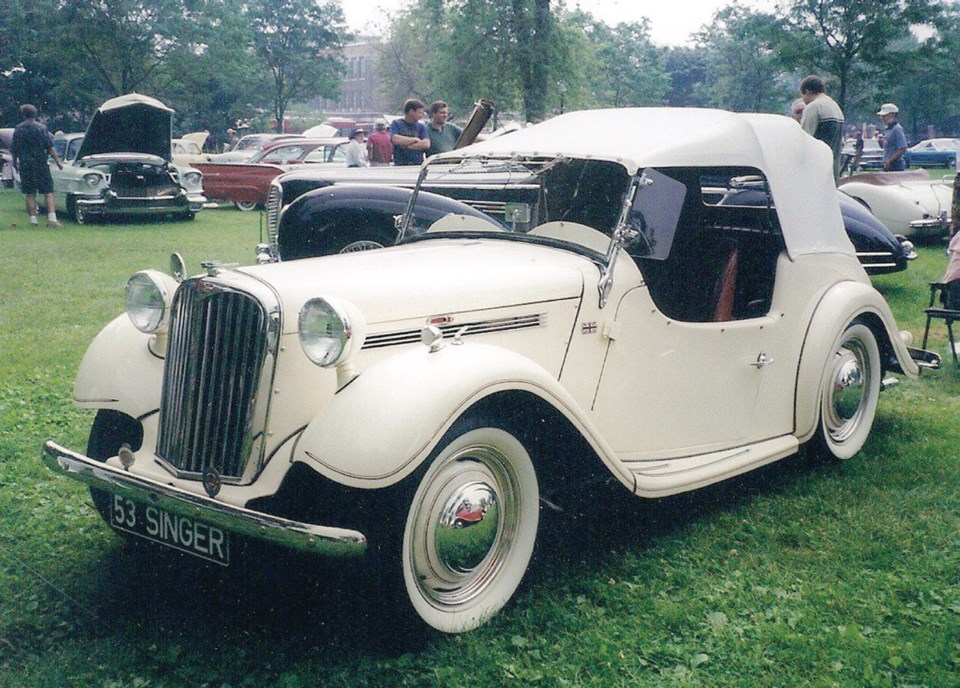In North America, the Singer name is associated more with sewing machines than with cars. Although there was a Singer car made in the United States, it had no connection to our subject.
The American-built Singer was manufactured in Mount Vernon, N.Y., from 1914 to 1918, and then in New York City from 1918 to 1920 by Singer Motor Company under the stewardship of Charles A. Singer, scion of the sewing-machine family. They were large luxury cars mostly powered by six-cylinder engines, although in a desperation move during the last year a few V-12s were offered.
The far better known Singer car came from Singer and Company Ltd., of Coventry, England. It also had a sewing-machine connection because Singer founder George Singer spent some early years as a mechanic with sewing-machine manufacturer Newton, Wilson and Company, and then Coventry Sewing Machine Company.
George Singer eventually abandoned sewing machines for the bicycle business, and in 1895 formed the Singer Cycle Company. After several years building two- and three-wheelers, some of them motorized, Singer & Co. entered automobile manufacturing in 1905, assembling Lea-Francis cars under licence.
Singer developed its own models and produced a variety of modestly successful two-, three- and four-cylinder cars, which culminated in the 1912 introduction of its first really successful Singer, the 10-horsepower model.
Others were added, and Singer prospered to the point that by the mid-1920s it was Britain’s third-largest auto manufacturer behind only Morris and Austin. When Singer introduced the Singer Junior in 1926 with an 848-cc, four-cylinder, overhead-camshaft engine, it set an overhead-cam pattern that it would follow with many of its cars for 30 years.
Although Singer produced several models during the 1930s, and enjoyed competition success, it suffered financially. With a re-organization in 1936, it survived the Depression.
Following the Second World War, Singer, like others, produced pre-war designs until it could design new models. It introduced the new SM1500 four-door sedan in 1948. With slab-sided styling and a horizontal fender line, the SM1500 somewhat resembled the 1947-1950 American Kaiser-Frazer. It began reaching North America in small numbers in 1950.
This modern, envelope-bodied design had independent coil-spring front suspension and a 50-horsepower, 1.5-litre overhead-cam four-cylinder engine. In spite of its “Americanized” look, the SM1500 sold very modestly in North America.
But English sports cars were gaining popularity, and Singer’s greater impact would come from a sporty little Singer that the company called a Roadster, although as a four-seater open car it was really a tourer or phaeton.
The Roadster was essentially a carry-over of a pre-war design, and arrived in North America as the Singer Nine. Its 1,047-cc, 37-horsepower overhead cam four produced pretty anemic performance, prompting Mechanix Illustrated car tester Tom McCahill to say it packed “all the wallop of a cream puff.” He opined that the car and the sewing machine had “power plants of similar output,” although he did say it handled nicely.
In 1952, the Nine was replaced by the revised SM1500 Roadster, fitted with the sedan’s 1.5-litre engine reduced in displacement from 1,506 to 1,497 cc. This brought it within the 1,500-cc competition class.
Road & Track tested a Roadster with the compression ratio raised from the standard 7.4:1 to 8.0:1. In spite of this slight hop-up, an overhead-cam engine and a quarter-litre of displacement more than the arch-rival MG TD, the testers found the 850 kg’s performance about equivalent to the TD’s. The Singer’s zero-to-100 km/h 17.0-second time was faster than the regular TD’s 19.4, but not as quick as the MGTD Mark II’s 16.5.
Top speed was also close. The Singer averaged 134 km/h, while the regular TD did 127 and the TD Mark II 131. With their boxy 1930s styling, neither was a paragon of aerodynamic efficiency.
Although performance of the MG and the Singer was comparable, the Singer lacked the longer hood and general styling panache of the MG. Both had cut-down doors, a fold-down windshield, clamshell fenders and free-standing headlamps, but in the two-seater MG they came out looking low and sleek while the four-passenger Singer looked high and ungainly. Also, the Singer lacked a tachometer, an inexcusable omission for a sports car.
Both were priced at about $2,200, but the more rakish MG TD outsold the Singer Roadster by a wide margin. The Roadster was produced until 1956, while the SM1500 sedan was discontinued in 1954.
Singer Motors was absorbed by the Rootes Group in 1955, and “real” Singers soon disappeared, replaced by badge-engineered Rootes products. The Singer name finally died in 1970, and Singers became, once again, just sewing machines.
